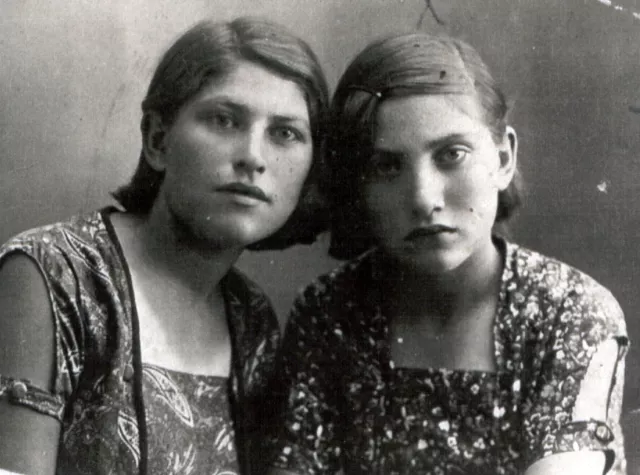Hava Goldshtein with her sister Sheindlia Goldshtein
I, Hava Goldshtein (right) and my sister Sheindlia Goldshtein photographed before my sister's wedding in Kalaya in 1938.
In 1931 I went to a Jewish school where my sister studied. This school was built at the time the Jewish colony was established. It was built at the Jewish neighborhood and was not far from or house. The only difference of this school from others was that teaching was in Yiddish. I learned Yiddish gradually and my sister helped me. I studied in this school for a year. In 1932 when famine began in Ukraine I was sent to a boarding school for orphaned and homeless children in hope that I would at least be getting some food there All children whose parents were not able to providefor them were admitted to this school. My sister stayed with our parents. These were horrific years when all grain was taken away from collective farmers, there was no food for cattle and my parents had no job. I remember my father and Shmul Bershak took me and Bershak's younger daughter to the silage facility at nighttime to come there unnoticed. We were tiny and thin girls and my father and Shmul lowered us into the silage pit on a rope tight on our feet where we picked silage: pressed prepared to feed cattle. Mother made pancakes that smelled of rot. I remember seeing a cart with dead people when my father was taking me to the boarding school: their swollen legs were sticking from a cover. The boarding school was in 15 kms from Kalay. We got soup and potatoes and some black buns. This was a Russian secondary school where we studied.
In 1934 when famine was over I stayed at the boarding school and finished the 10th form there, my sister finished Jewish school in 1930. The school was closed in late 1930s. There were Jewish, Russian, Ukrainian and Crimean Tatar children in my class. We never cared about one another's nationality. We were friends. I became a pioneer in the school, but I took no interest in any public activities. Besides, I was not quite successful with my studies. I didn't like reading or writing or mathematics. I much preferred to spend time with animals helping my father and help my mother in the chicken yard and on the farm.
In 1938 after finishing school I entered Medical College in Kalay. I finished it in 1940. My older sister Sheindlia graduated from Teachers' Institute in Simferopol. She worked at a school in Kalay as a teacher of mathematic. In 1938 Sheindlia married Shura Friedental, a Jew, our neighbor. He was a driver in the collective farm. The whole collective farm celebrated the wedding in our yard under the tents. There was no chuppah or religious ceremony at the wedding since Shura and my sister were convinced atheists and Komsomol members, but there was Jewish music played and guests danced Jewish folk dances. The newly weds lived in our house. In 1939 their daughter Rita was born.
After finishing medical college in spring 1941 I became a medical nurse at a school in Kalay the same where my sister worked. I worked there for about half a year until we heard on the radio about the beginning of war on 22 June 1941. We didn't quite understand what was going on - we were convinced that our country was so powerful and a war was something we couldn't believe might happen or that somebody dared to attack us.












